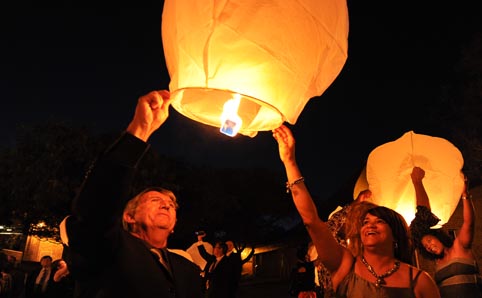 |
|
Lanterns filled the night sky as UFS staff and guests celebrate the launch of the School of Open Learning at the university’s South Campus.
Photo: Johan Pretorius
|
A school which intends to expand the boundaries of the University of the Free State (UFS), providing good quality higher education that is based on open learning principles. That is what the School of Open Learning at the UFS’ South Campus is all about. The School was officially launched at the Campus on 28 November 2011.
Prof. Daniella Coetzee, Dean of the School, told guests at the launch that the School will provide opportunities other than traditional learning in higher education and open up access to those who have not had the opportunity to study at a higher education institution. This includes taking programmes and courses to students at off-campus sites. The School of Open Learning currently has 46 off-campus sites across most of the provinces, i.e. Mpumalanga, KwaZulu-Natal, North West, Eastern Cape, Northern Cape, Limpopo and the Free State. The off-campus sites are serviced by a total of 350 university lecturers and well-trained facilitators and tutors.
At the moment most of the programmes and courses managed by the School of Open Learning have their academic home in the Faculty of Education, providing upgrading of the qualifications of teachers as well as in-service training. In 2011 the School of Open Learning enrolled more than 4000 students for the Education courses. To date a total of 28 000 teachers have been enrolled at the School to upgrade their teaching qualifications.
Collaboration with the Faculty of Law in the presentation of a BIuris degree on off-campus sites is also on the calendar for 2012. This degree will be offered through contact and E-learning at three off-campus sites: Johannesburg, Durban and Cape Town.
The University Preparation Programme (UPP) will also form part of the School of Open Learning. This programme has proven to be extremely successful in providing students access to undergraduate degrees at the UFS. The curriculum for this bridging year offers courses from the Faculties of Economic and Management Sciences, Human and Social Sciences as well as Natural and Agricultural Sciences. Since 1993 more than 4500 students have enrolled for degree purposes after successfully completing the UPP: 1641 degrees have been awarded to students who began their studies in the programme (including 168 honours degrees; 25 master’s and 8 M.B.Ch.B. degrees). The existing foundation course in the UPP is being adapted to also serve NQF level 4 in further education. As far back as 1998, the Sunday Times (Best in Education, 1998:1) named this programme as “one of the most innovative education programmes” in a special supplement on higher education in South Africa.
Also speaking at the event, Prof. Jonathan Jansen, Vice-Chancellor and Rector, said the South Campus is to become intellectually alive with possibilities. He said the university will make sure there are seminars, conferences and classes where students can mingle across the university’s three campuses.